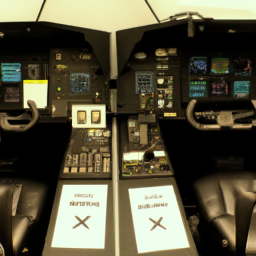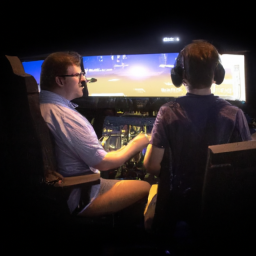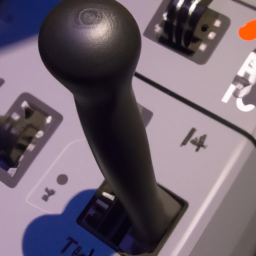In this article, we will explore the contrasts between civil aviation simulators and military aviation simulators. You will discover the key distinctions and understand how each type serves its purpose. By the end, you will have a clear understanding of the unique features and functionalities that make these simulators valuable training tools in their respective fields.
Civil Aviation Simulators
Purpose and Training
Civil aviation simulators serve the purpose of providing realistic training scenarios for pilots in a controlled and safe environment. These simulators are designed to replicate the experience of flying commercial aircraft and enable pilots to practice various flight maneuvers, emergency procedures, and navigation techniques.
The training offered in civil aviation simulators covers a wide range of areas, including takeoffs and landings, instrument flight rules (IFR) procedures, handling of system failures, and decision-making in challenging situations. Pilots can also simulate flights in different weather conditions and practice communication with air traffic control.
The main objective of civil aviation simulators is to enhance pilot skills, improve situational awareness, and ensure readiness for real-world flight operations. These simulators play a critical role in pilot training programs, offering a cost-effective and efficient means of practice and skill development.
Realism and Environment
Civil aviation simulators strive to provide a highly realistic experience for pilots by replicating the aircraft’s cockpit and controls as accurately as possible. The cockpit layout, instrumentation, and control interfaces are designed to closely resemble those found in the actual aircraft, allowing pilots to familiarize themselves with the equipment and its operation.
Furthermore, civil aviation simulators integrate real-world environments into their training scenarios. This includes realistic depictions of airports, air traffic control systems, and geographical landmarks. By immersing pilots in an environment that closely mirrors real-world conditions, simulators enable them to hone their situational awareness and decision-making abilities.
The simulation capabilities of civil aviation simulators go beyond visual and auditory immersion. They incorporate realistic flight dynamics, accurate modeling of weather conditions, and accurate replication of aircraft systems. These factors contribute to creating a training environment that closely resembles real-world flying scenarios.
Regulations and Certifications
Civil aviation simulators must adhere to international regulatory standards to ensure their effectiveness and safety. These standards define the requirements for simulator fidelity, performance, and the accuracy of simulation models. Compliance with these standards is necessary to obtain certifications for civil aviation simulators.
The certification process for civil aviation simulators involves a series of evaluations and tests conducted by regulatory authorities. These assessments assess the simulator’s performance and fidelity to ensure that it accurately reproduces the aircraft’s behavior and response. Certifications are typically granted for specific aircraft types or families, ensuring that pilots receive training on the equipment they will operate.
Maintenance and security requirements are also part of the regulatory framework for civil aviation simulators. Regular maintenance and calibration of simulator hardware and software are essential to maintain their accuracy and reliability. Security measures, such as access control and cybersecurity protocols, are implemented to protect the simulators and the sensitive data they may contain.
Military Aviation Simulators
Combat Scenarios and Training
The primary objective of military aviation simulators is to train military aviators for combat scenarios and develop their tactical skills. These simulators replicate various combat situations and enable pilots to practice aerial combat maneuvers, air-to-air engagements, and tactical decision-making in realistic environments.
Military aviation simulators offer a wide range of training scenarios, including dogfights, air-to-ground attacks, reconnaissance missions, and tactical evasive maneuvers. These simulations enable pilots to practice their skills, develop strategies, and assess the effectiveness of their decision-making in combat situations.
The importance of realistic combat training cannot be overstated. Military aviators must be prepared for the fast-paced and dynamic nature of aerial warfare. Simulators allow them to experience and learn from these scenarios without the inherent risks associated with real combat situations.
Advanced Technologies and Simulations
Military aviation simulators leverage cutting-edge technologies to provide a high-fidelity training experience. These simulators incorporate advanced computer graphics, realistic physics engines, and sophisticated simulation models to replicate the behavior of complex military aircraft systems and weapons.
Simulators accurately model the flight characteristics and performance of various military aircraft, including fighter jets, helicopters, and unmanned aerial vehicles (UAVs). This level of accuracy allows pilots to practice the operation of the specific aircraft they will fly in real-world missions.
Furthermore, military aviation simulators emphasize training for tactical decision-making. Pilots are exposed to complex scenarios that require them to assess threats, plan missions, and make critical decisions in real-time. Simulators allow them to refine their decision-making skills, evaluate different strategies, and learn from the outcomes of their choices.
Security and Confidentiality
Military aviation simulators operate under strict security measures to protect classified information and maintain confidentiality. These simulators handle sensitive data, including mission plans, weapon systems, and operational procedures. As a result, robust security protocols are in place to safeguard these assets.
Access to military aviation simulators is tightly controlled, with only authorized personnel granted permission to operate them. Biometric authentication, personal identification codes, and physical security measures are implemented to prevent unauthorized access.
In addition to physical security, military aviation simulators prioritize data protection and confidentiality. Data encryption, secure network protocols, and strict data handling procedures ensure that classified information remains secure and cannot be intercepted or compromised.
Countermeasures against cybersecurity threats are also a top priority in military aviation simulators. Robust firewalls, intrusion detection systems, and regular vulnerability assessments are performed to identify and mitigate potential risks. Continuous monitoring and updates are implemented to stay ahead of evolving cyber threats.
Conclusion
In summary, civil aviation and military aviation simulators differ in their purpose, training objectives, and operational requirements. Civil aviation simulators focus on providing realistic training environments for commercial pilots, emphasizing skills development and safety. On the other hand, military aviation simulators are designed to prepare military aviators for combat scenarios, stressing tactical decision-making and mission readiness.
Both types of simulators incorporate advanced technologies to deliver a highly realistic experience. Civil aviation simulators replicate cockpit controls and real-world environments, while military aviation simulators additionally simulate complex weapon systems and combat scenarios. These simulators play a crucial role in enhancing aviation safety, proficiency, and combat readiness.
Tailored training in civil and military aviation simulators is essential to meet the specific requirements of each field. The differences in training objectives and scenarios necessitate distinct approaches in simulator design and training programs.
Ultimately, simulators play a vital role in the aviation industry by enabling pilots to gain valuable experience, hone their skills, and prepare for real-world operations. The ongoing advancements in simulator technology ensure that aviation professionals are equipped with the necessary knowledge and expertise to navigate the complexities of their respective fields safely and effectively.




